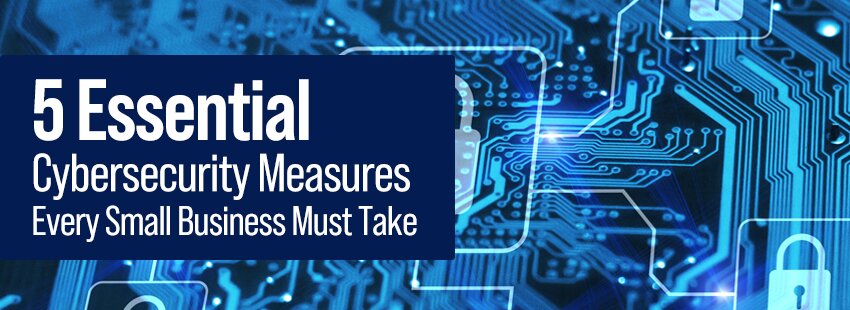
5 Essential Cybersecurity Measures Every Small Business Must Implement
Introduction
In an increasingly digital world, small businesses find themselves at the forefront of a silent war against cybercriminals. The misconception that cybercriminals only target large corporations has left many small enterprises vulnerable and unprepared. This comprehensive guide aims to equip small business owners with the knowledge and tools necessary to fortify their digital defences, protecting not just their data, but their reputation and financial stability as well.
The Critical Importance of Cybersecurity for Small Businesses
Small businesses are often seen as low-hanging fruit by cybercriminals due to their typically less robust security measures compared to larger corporations. A2021 report by Verizon revealed that 43% of cyber-attacks target small businesses. The consequences of such attacks can be devastating, with the average cost of a data breach for small businesses reaching $149,000 according to IBM's Cost of a Data Breach Report. Beyond the immediate financial impact, cyber-attacks can lead to loss of customer trust, damage to reputation, and in severe cases, business closure.
The digital landscape is evolving rapidly, and with it, the sophistication of cyber threats. Ransomware attacks, phishing schemes, and malware infections are just a few of the weapons in a cybercriminal's arsenal. Small businesses must recognize that cybersecurity is not a luxury, but a fundamental aspect of modern business operations. By implementing robust security measures, small businesses can not only protect themselves but also gain a competitive edge by demonstrating their commitment to data protection to customers and partners alike.
Five Essential Cybersecurity Measures for Small Businesses
1. Implementing Strong Password Policies
The first line of defense in any cybersecurity strategy is a robust password policy. Weak passwords are akin to leaving the front door of your business unlocked. A strong password policy should include:
∙ Minimum length requirements (at least 12 characters)
∙ Complexity rules (combination of uppercase and lowercase letters, numbers, and symbols)
∙ Regular password changes (every 60-90 days)
∙ Prohibition of password reuse
∙ Implementation of multi-factor authentication (MFA)
Multi-factor authentication adds an extra layer of security by requiring users to provide two or more verification factors to gain access to a resource. This could be something they know (password), something they have (a smartphone), or something they are (biometric verification). According to Microsoft, MFA can block 99.9% of automated attacks.
Small businesses should also consider implementing a password manager to help employees create and store complex passwords securely. This not only enhances security but also improves productivity by reducing time spent on password resets and lockouts.
2. Regular Software Updates and Patching
Outdated software is a goldmine for cybercriminals. Software vulnerabilities are discovered constantly, and developers release patches and updates to address these issues. Failing to apply these updates promptly leaves your systems exposed to known vulnerabilities that hackers can easily exploit.
Establishing a regular update and patching schedule is crucial. This should include:
∙ Operating system updates
∙ Application updates
∙ Firmware updates for hardware devices
∙ Plugin and extension updates for web applications
Automating the update process where possible can ensure that critical security patches are applied promptly. For businesses with more complex IT environments, consider implementing a patch management system to streamline the process and ensure no device or application is overlooked.
It's also important to note that some legacy systems may no longer receive security updates. In such cases, businesses should plan to migrate to supported alternatives to maintain a strong security posture.
3. Employee Training and Awareness
The human element is often the weakest link in the cybersecurity chain. A well-intentioned but uninformed employee can inadvertently compromise an entire network by falling for a phishing scam or using weak passwords. Comprehensive and ongoing employee training is therefore essential.
An effective cybersecurity awareness program should cover:
∙ Recognizing and reporting phishing attempts
∙ Safe browsing practices
∙ Proper handling of sensitive data
∙ The importance of software updates and patch management
∙ Social engineering tactics used by cybercriminals
∙ Mobile device security
Training should not be a one-time event but an ongoing process. Regular simulated phishing exercises can help keep employees vigilant and provide measurable data on the effectiveness of your training programs. Consider implementing a reward system for employees who consistently demonstrate good cybersecurity practices or who identify and report potential threats.
Creating a culture of cybersecurity awareness is crucial. Encourage open communication about security concerns and make it clear that reporting potential issues is valued and expected. This proactive approach can help catch and mitigate threats before they escalate into full-blown security incidents.
4. Data Backup and Recovery Plans
In the event of a successful cyber-attack, a robust data backup and recovery plan can be the difference between a minor setback and a catastrophic loss. The3-2-1 backup rule is a good starting point for small businesses:
∙ 3: Keep at least three copies of your data
∙ 2: Store two backup copies on different storage media
∙ 1: Keep one backup copy offsite
Cloud-based backup solutions can provide an efficient and cost-effective way for small businesses to implement this strategy. These services often offer automated backups, ensuring that your data is consistently protected without requiring manual intervention.
However, having backups is only half the battle. Regularly testing your recovery process is crucial to ensure that you can actually restore your data when needed. Conduct periodic drills to simulate data loss scenarios and practice your recovery procedures. This will help identify any gaps in your plan and ensure that your team is prepared to act swiftly in a real emergency.
Your backup and recovery plan should also address:
∙ Recovery Time Objectives (RTO): How quickly you need to recover your data
∙ Recovery Point Objectives (RPO): How much data you can afford to lose
∙ Prioritization of critical data and systems
∙ Procedures for different types of data loss scenarios (e.g., ransomware attack, hardware failure, natural disaster)
5. Implementing Firewalls and Antivirus Software
Firewalls and antivirus software form a critical defence against external threats. A firewall acts as a barrier between your internal network and the internet, monitoring and controlling incoming and outgoing network traffic based on predetermined security rules. Meanwhile, antivirus software scans for, detects, and removes malicious software from your systems.
For small businesses, a next-generation firewall (NGFW) is often a good investment. NGFWs offer advanced features such as:
∙ Intrusion Prevention Systems (IPS)
∙ Application awareness and control
∙ Advanced malware protection
When it comes to antivirus software, look for solutions that offer real-time protection, regular updates to their threat database, and features like email scanning and web browsing protection. Many modern antivirus solutions also include anti-malware, anti-spyware, and anti-ransomware capabilities.
It's important to note that while consumer-grade antivirus software might be sufficient for very small businesses, as your business grows, you should consider enterprise-level endpoint protection platforms. These offer more comprehensive security features and centralized management capabilities.
Regular scans should be scheduled, and all devices connected to your network, including mobile devices and IoT devices, should be protected. Additionally, ensure that your firewall and antivirus software are always up-to-date to protect against the latest threats.
Cost-Effective Implementation Strategies
While the importance of cybersecurity is clear, many small businesses struggle with the perceived costs of implementation. However, there are several strategies to enhance your cybersecurity posture without breaking the bank:
- Leverage open-source tools: Many robust cybersecurity tools are available for free. For example, ClamAV for antivirus protection or Snort for intrusion detection.
- Utilize cloud-based security services: These often operate on a pay-as-you-go model, allowing you to scale your security measures with your business growth.
- Invest in employee training: This can be one of the most cost-effective security measures. Many free or low-cost online resources are available for cybersecurity awareness training.
- Implement basic security measures thoroughly: Properly implementing fundamental security practices like strong passwords and regular updates can significantly enhance your security posture at little to no cost.
- Consider managed security services: For businesses without dedicated IT staff, outsourcing to a managed security service provider can be more cost-effective than hiring full-time security personnel.
Remember, the cost of implementing these security measures is likely to be far less than the potential cost of a successful cyber-attack. View cybersecurity as an investment in your business's future rather than an expense.
Conclusion: Taking Action to Secure Your Business
In today's digital landscape, cybersecurity is not optional – it's a necessity for businesses of all sizes. The five measures outlined in this guide – strong password policies, regular software updates, employee training, data backup and recovery plans, and implementing firewalls and antivirus software – form the foundation of a robust cybersecurity strategy.
However, cybersecurity is not a one-time implementation but an ongoing process. Threats evolve, and so must your defences. Regular security assessments are crucial to identify vulnerabilities and ensure that your security measures remain effective.
Take action today to protect your business. Start by conducting a thorough assessment of your current security posture. Identify gaps and prioritize improvements based on your specific risks and resources. Remember, every step you take towards better security reduces your risk and strengthens your business.
In an era where data is often a company's most valuable asset, protecting that data is protecting your business's future. By implementing these essential cybersecurity measures, you're not just defending against threats – you're investing in your business's resilience, reputation, and long-term success.
Click below to request a FREE Cybersecurity Assessment from Tros Technologies today
